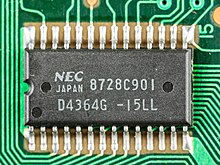CMOS RAM
The term CMOS-RAM , actually CMOS static RAM (English), in the computer technology and PC industry, describes a battery-buffered SRAM in CMOS technology, in which the BIOS parameters are saved. Battery backup is necessary because otherwise the settings / information would be lost or reset to the standard settings.
The abbreviation comes from the fact that CMOS-SRAM was usually implemented with a Complementary Metal Oxide Semiconductor (CMOS) static random-access memory (SRAM). The abbreviated designation "CMOS-RAM" or even "CMOS" is primarily due to inaccuracies in the use of the terms.
Power supply
The CMOS RAM and the PC clock are usually fed by a CR2032 lithium battery (also called CMOS battery in terms of function). These batteries usually last between two and ten years, depending on the mainboard , the ambient temperature and the separation from the power supply of the PC. Higher temperatures and longer times when the PC is disconnected from the mains shorten the service life of the battery.
If the battery for the CMOS-RAM is changed, the system time and the CMOS-RAM can be reset. It is therefore generally recommended to change the battery with the power supply switched on but the computer switched off. In the case of motherboards in ATX format , a supply voltage of 3 V is supplied, with which the CMOS-RAM is supplied with power even without a battery.
The opposite problem can also arise in practice. If you want to specifically reset the BIOS settings and the system time by deliberately removing the battery from its socket, this can sometimes take an hour or even longer. In order to avoid this waiting time, the small residual energy of the buffer capacitors located on the circuit board has to be discharged. To do this, completely disconnect the device from the power supply, remove the battery and short-circuit the two battery contacts in the battery holder for about a second, e.g. B. by touching both at the same time with the metal tip of a screwdriver.
A button cell is not always used as a CMOS battery - there are also computers with cylindrical mignon cells , for example in the Power Mac (G3 / G4 / G5) , and earlier also small nickel-cadmium batteries in the form of small tons (for example in Amigas ) and, in the 1990s, often also as a Dallas chip . Due to the RoHS guidelines, however , nickel-cadmium batteries are no longer permitted in this area of application for new devices.
literature
- Klaus Dembowski: BIOS and Troubleshooting . Pearson Education, 2004, ISBN 978-3-8272-6547-0 , pp. 437 ff .
- Hans-Peter Messmer, Klaus Dembowski: PC hardware book: Structure, functionality, programming . Pearson Education, 2003, ISBN 978-3-8273-2014-8 , pp. 658 ff .

